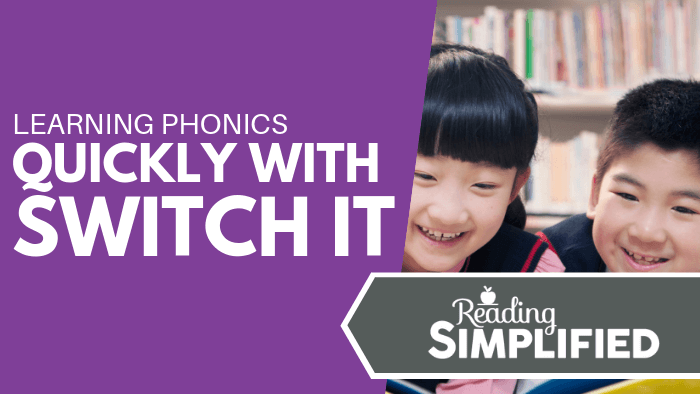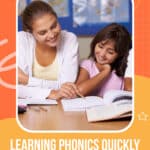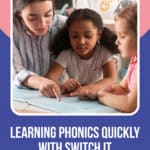
Do you ever stop and think…why do so many reading programs encourage us to teach reading sub-skills in an isolated manner?
Phonological awareness is separate from phonics. Letter names are separate from letter-sounds. And handwriting. High-frequency words are separate from phonemic awareness, etc.
However, when you integrate early reading steps simultaneously into the context of words, it saves a lot of instructional time. Zip students right into real reading, instead.
Additionally, the teacher's burden is reduced because fewer activities are required and integrating multiple reading sub-skills saves so much instructional time that s/he's less likely over-burdened by the overwhelm of too much to do.
In this article, I’m going to give you my top tips for reducing the amount of structural planning time it takes to up your students reading achievement at a rapid rate.
{To watch the video where I explain how you can get kids learning phonics quickly with the Switch It activity, hit play below or read on for a detailed overview}
When we stop to consider just how many reading sub-skills we’re expected to teach in isolation, it can be pretty overwhelming...
• Letter Names
• Letter Sounds
• Oral Phonological Awareness
• Oral Phonemic Awareness
• Handwriting
• Decoding
• Sight Words
• Vocabulary
• Phonics
• Word Families
• Alphabetizing
• Comprehension Strategies
• Genres
• Writer’s Craft
• Composition
• Fluency
• Speaking
• Listening
• Grammar
• Mechanics
• Concepts of Print
Phew! What a long list, right?
Imagine how much time you could save by integrating various elements of reading instruction rather than teaching each part in isolation? Kids could be learning phonics so much quicker!
Here are 3 inefficiencies in a well-known reading program that we could tweak to give all students earlier access to reading...
Why should we abandon isolated instruction?
1. Letter-Sounds aren’t added until week 5
In the reading program demonstrated in the video, we see that it doesn’t introduce letter-sounds until the fifth week of instruction. Instead, the program focuses on letter names first. While letter names are helpful for spelling orally and alphabetizing, they aren’t that helpful when it comes to learning how to read.
Taking five weeks to introduce letter names slows kids down and doesn’t reveal how our written code works. Some children don't "get" the concept of the alphabetic principle (the concept that our written language is a code for sounds) when we begin with letter names. As a result, letter names (and sounds) stick less for these types of learners because they don't have a mental hook, or schema, on which to attach the flood of paired-associate learning of letter symbols with their names.
2. Decoding isn’t introduced until week 7
Another issue with this reading program examples is that it doesn't put the letter-sounds together in the context of a real word until week 7.
Some reading programs will take even longer than that, which means our kiddos lack the basic understanding of words because it hasn’t been put into the real context of reading for them.
3. Segmenting and blending of real words delayed
In this example reading program segmenting and blending with real words doesn't begin until week 30. They start with the oral phonemic level, and they don’t get segmenting or connecting all the letter-sounds until week 30, which is a considerable delay in what's possible for a child's rate of reading growth.

Integrating Multiple Reading Subprocesses with Switch It
Wouldn’t it be great if you could bring multiple reading subprocesses together with just one activity?
Well, now you can with the activity, Switch It.
Switch It is a core activity we teach here at Reading Simplified. It works by asking students to switch singular sounds (phonemes) in and out of words with a focus on sound-symbol correspondence.
For example, we might begin with a word such as “map.”
The teacher then asks the student to switch out a letter-sound of the first word to create a new word, such as “mat.”
It’s up to the students to hear the sounds, which encourages them to work on their phonemic segmentation and phonemic manipulation skills. Once the students can switch the correct letter-sounds to create the new word, the teacher accelerates the challenge by moving onto four or five letter-sound words.
A solution for every age…
Switch It works for students of all ages.
I’ve worked with kids ranging from beginners to high schoolers, and each of them shows terrific growth using this one activity.
If older kids are struggling with learning phonics, it’s most likely got something to do with their sound-symbol decoding foundation being weak. This means that they don’t see how sounds and symbols line up. Instead, their decoding break down, which causes challenges in word identification, fluency, and comprehension. Switch It can help remedy these sound-symbol decoding weaknesses.
Everything we teach in separate compartments, you can do simultaneously with Switch It. For younger readers, you can focus on easier CVC words such as SAP to SAT. When you’re ready to up the difficulty, you can use words such as STOMP to STAMP.
If your kids are total beginners and don’t know any letter-sounds and have never read a word in their lives, you can use the Build It activity first, and then move onto Switch It when they’re ready.
Build It is the perfect first step for brand-new beginning readers. It helps them to learn their letter-sounds, develops phonemic awareness, decoding and spelling. If you’d like to find out more about this activity and get your hands on some free lesson plans while you’re at it, visit this post, “Lesson Plans for Brand New Readers” - which is a great way to get kids learning phonics quickly.
If you’d like to grab a FREE sample of one of the worksheets we supply to members of the Reading Simplified Academy, all you have to do is visit our Facebook page and write a comment on this Facebook post – the free worksheet that includes high-frequency words will be delivered to you via Facebook Messenger.
For more freebies like this and unlimited access to teaching supplies, a supportive community and solutions for every one of your struggling readers, join the Reading Simplified Academy today!




Hi Marnie,
I am a newbie to your website and I love it. I teach in a Private school and am moving to a Prep class (your kinder I think) in Melbourne, Australia next year (end of Jan 2019) when our school year begins. We have EAL students in our school mostly from a Chinese background and many of them don’t know how to speak English let alone read it. Do you have a specific order in which to teach letter sounds so they aren’t taught in isolation? I am learning so much from your videos already and wish I had seen them earlier.
Kindest regards,
Naomi
Thanks for your interest in Reading Simplified and your kinds words Naomi! 🙂
Yes, we have a general sequence that’s represented by our Streamlined Pathway. It’s a 1-page scope and sequence of a kind. Each step includes key letter-sounds to target. Generally, we aim to introduce the most frequent letter sounds (i.e., s, r, p, t…) and more frequent short vowels as soon as possible. But whether one introduces p or t first really isn’t that important.
You can find an example of 1 level of our Streamlined Pathway here.
I can’t find out how to buy the switch it lists! I have done the first 4 lists with my strugglers and am having huge success. Please tell me how to purchase the other lists
Thanks for your interest, Summer! Most of our materials are on reserve for members of our Reading Simplified Academy and not for individual sale. You can learn more about the Academy here: ReadingSimplified.com/academy
Hi,
I have the free program. How do I get the whole thing?
We’d love to have you join us! Here’s a link: ReadingSimplified.com/academy
Thank you Melissa!
I have been doing Switch It with all my students and it has been very successful. I’m wondering about introducing new sounds to very young learners. Do I need to teach them the mouth movements and tongue and lips positions to introduce new sounds? It feels very unnatural to me as I sometimes don’t even know how my mouth is making the sounds!!
Great to hear about their success Cathie!!
No, we don’t find that most students need to know much about mouth movements or tongue/lip positions. If one sound is tripping a child up, we may draw attention to our own mouths or theirs to try to give another sensory input. But this is few and far between.
Mainly, we just lay out a new letter-sound on the Build It or Switch It board and see if that child can determine which sound goes where. When a child has identified the sound but doesn’t recognize which letter-sound corresponds to it, we simply point to the right card and say, “This is /t/” for instance. You can see how fast this works in mini-experiments I ran with a 4 year-old here and a 5 year-old here.
How do I reference Switch it in APA 7 format? I am writing a paper for my master’s and want to give appropriate credit. I used Switch It in my kindergarten classroom and loved the results with my students. Thank you
I’m not sure! I would cite it like a game or a website, depending on what APA suggests for one of those.